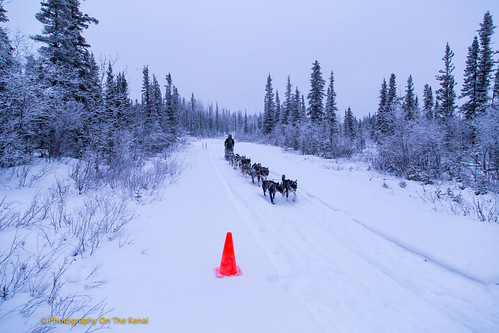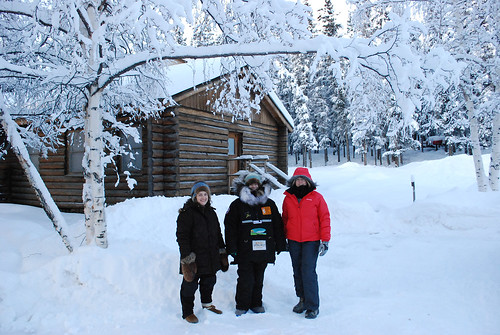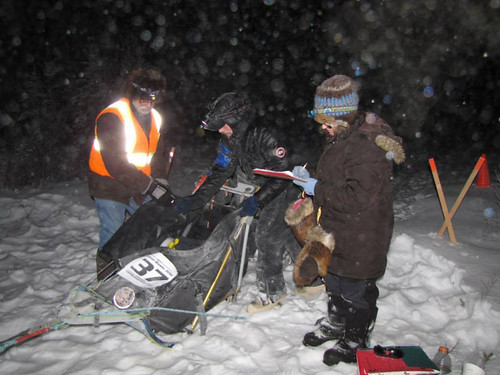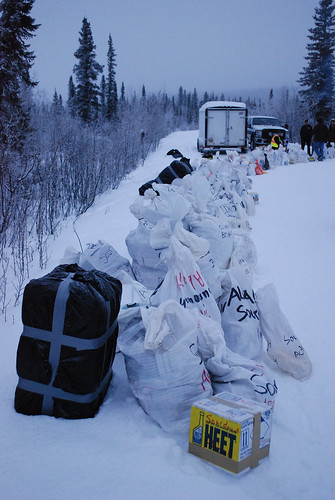
Think Alaska in the winter: a large land canvas of powdery, granular or icy snow and days of often very, very cold weather.
With those conditions, it’s off to the races for some of the heartiest Alaskan sled dogs and volunteers like U.S. Forest Service employee Carol Teitzel, who works in the U.S. Forest Service Alaska Region and who lent her support to the excitement and challenge of this year’s Copper Basin 300 Sled Dog Race.
The 310-mile competition counts as a qualifying race for the nearly 1,000-mile Iditarod, the most popular dog sled race, and the 1,000-mile Yukon Quest, sometimes called the world’s toughest dog sled race.
The Copper Basin 300 is referred to as “the toughest 300 miles in dog racing.” If that’s true, then the Copper Basin 300 Sourdough checkpoint at Milepost 148 on the scenic Richardson Highway might possibly be termed the toughest checkpoint in dog racing. It is notoriously one of the toughest checkpoints to find volunteers to staff.
One of the coldest checkpoints on the trail, it offers very few amenities, and it’s void of communication with race central because of its location in a low hollow. For the last few years, land managers in the area have recognized these difficulties and have pitched in to find ways to be supportive of the community’s efforts and provide help where there’s been a need.

“My husband and I are both part of the federal land management team here in Alaska, and I thought this was just one more way to enjoy the beauty of the land and to be part of a team to celebrate the races,” said Teitzel, a visual information specialist. “Interior Alaska is geographically different from southeast Alaska where I previously worked in the regional office. Winters here will dip in the minus 40- to minus 50-degree range. Just walking outside can cause injury if you are not prepared. But it is a way of life with winter being a key time for Alaskan celebrations and events.”
Volunteers provided satellite phones for communication with race central to relay important updates to anyone watching the race online or from afar. They also set up the checkpoint with warming tents, burn barrels, wood, and warm stew for the mushers. Volunteer checkers were available around the clock starting at 11:53 a.m. January 11 when the first musher arrived into the checkpoint, until 11:30 a.m. January 12 when the final musher departed.
Focusing on the conservation education mission of the race this year, Teitzel reached out to Heidi Sutter, a local Copper Basin teacher and musher, for more information on the sport and for ways to keep her grandchildren in the Lower 48 involved. Together, they drew on the Chugach Children’s Forest’s iTrec! Iditarod Trail to Every Classroom program.
“These workshops focus on the belief that students who are immersed in the interdisciplinary study of their own ‘place’ are more eager to be involved in the stewardship of their communities and public lands,” said Teitzel.

Simplifying some of the program activities, Teitzel and Sutter covered many topics involved in dog sled racing including wilderness survival techniques, animal husbandry and applying math skills for racing requirements and tracking results. “The kids came to understand how to prepare for and run a race while also ensuring good environmental stewardship,” she said.
As a qualifier race for the Iditarod, the Copper Basin 300 has an international following on social media. Teitzel introduced a Twitter feed for this year’s competition that she hopes will bring in more volunteers and support for next year’s race.
The Sourdough checkpoint operations this year involved a cooperative effort with volunteers and staff from the Bureau of Land Management, Wrangell St. Elias National Park and Preserve, and the Ahtna Native Regional Corporation, in addition to the U.S. Forest Service Alaska Region.

